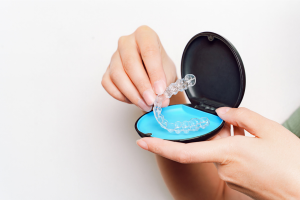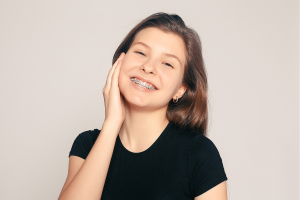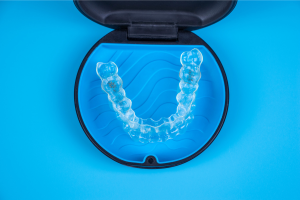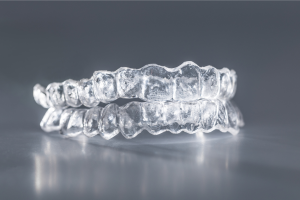Invisible teeth braces, or clear aligners, have revolutionised adult orthodontic care in the UK. They offer a discreet, comfortable, and flexible alternative to metal braces — ideal for professionals and adults who prefer a subtle solution. Yet many patients wonder whether clear aligners can correct more complex bite issues such as open bite, crossbite, and deep bite.
In this blog, we’ll explore how modern clear aligner systems work, what types of bite problems they can treat effectively, and where their limitations lie.
Understanding Bite Problems
A “bite” refers to how your upper and lower teeth meet when your mouth is closed. A correct bite allows for even chewing, balanced pressure, and proper jaw function. When the teeth or jaws do not align properly, it results in what orthodontists call a malocclusion.
The three most common malocclusions seen in adults are:
- Open Bite: The upper and lower front teeth don’t meet when you close your mouth, leaving a visible gap. This can affect speech and make biting into food difficult.
- Crossbite: Some upper teeth sit inside the lower teeth when biting down, often causing uneven wear or jaw strain.
- Deep Bite: The upper front teeth excessively overlap the lower teeth, sometimes causing gum trauma or enamel wear on the lower incisors.
These bite problems aren’t just aesthetic — they can lead to jaw discomfort, speech changes, tooth wear, or even gum recession over time. For adults in the UK considering orthodontic correction, clear aligner treatment has become a popular choice to restore both function and appearance.
How Clear Aligners Work
Clear aligners are transparent, removable trays custom-made to fit snugly over your teeth. They apply gentle, consistent pressure to move teeth gradually into better alignment. Using 3-D scans and digital treatment planning, clinics such as ProAligners London design a sequence of aligners that each make small, precise movements.
Patients typically wear each set for one to two weeks, 20–22 hours per day, removing them only for meals and cleaning. Over time, these micro-adjustments guide the teeth — and sometimes the bite — into their proper position.
But while clear aligners are highly effective for many types of orthodontic cases, their ability to correct complex bite discrepancies depends on the severity and type of malocclusion.
Can Clear Aligners Fix an Open Bite?
In many cases, yes — clear aligners can successfully treat mild to moderate open bites, particularly those caused by tooth position rather than skeletal jaw problems.
An open bite occurs when the front or back teeth fail to make contact, leaving a gap even when the jaws are fully closed. This can be due to habits such as thumb sucking or tongue thrusting, or from the vertical position of certain teeth.
Modern aligner systems use digital tooth movement staging to intrude (move upward) or extrude (move downward) teeth gradually, closing the open space. Attachments — small, tooth-coloured bumps placed on certain teeth — help aligners apply targeted forces to move teeth vertically.
For patients whose open bite stems from dental causes, such as slightly over-erupted back teeth or misaligned front teeth, clear aligners work very well. They can achieve a stable, aesthetic closure when used consistently and under professional supervision.
However, aligners have limitations for skeletal open bites, where the problem lies in jaw growth or bone positioning rather than the teeth themselves. For example, if the upper jaw is vertically longer or the lower jaw sits too far back, aligners alone cannot reposition the bones. Such cases may require a combination of orthodontics and jaw surgery (orthognathic surgery) for complete correction.
In summary, clear aligners can correct mild to moderate dental open bites, but severe skeletal open bites often need specialist intervention. A proper 3-D assessment by a GDC-registered orthodontist or dentist is essential to determine suitability.
Can Clear Aligners Correct a Crossbite?
Crossbites occur when one or more upper teeth bite inside the lower teeth. They can affect the front teeth (anterior crossbite) or back teeth (posterior crossbite).
For adults with mild to moderate crossbites caused by tooth misalignment, invisible braces can be highly effective. Through programmed tooth movement and the use of precision “attachments” and elastics, clear aligners can gradually expand the dental arch or reposition specific teeth outward to achieve proper alignment.
For example, in a mild posterior crossbite involving one or two teeth, aligners can apply outward pressure to the upper molars to correct the bite relationship. Similarly, mild anterior crossbites can be resolved by moving upper front teeth forward and lower front teeth slightly back.
That said, severe crossbites — especially those linked to jaw asymmetry or narrow skeletal arches — present a greater challenge. If the upper jaw itself is too narrow compared to the lower jaw, clear aligners cannot expand the bone structure enough to correct it fully. Such skeletal crossbites often require early orthodontic intervention or fixed appliances that can apply stronger, multi-directional forces.
In adult patients, aligners can sometimes be combined with other techniques, such as interproximal reduction (IPR) — a controlled polishing between teeth to create space — or even mini-implants to aid expansion. Clinics offering Clear Aligners in London often use advanced software to simulate the potential correction before treatment begins, helping to predict outcomes accurately.
In short, clear aligners can correct tooth-based crossbites, but jaw-based crossbites may still require fixed orthodontics or surgical support for complete resolution.
Can Clear Aligners Fix a Deep Bite?
A deep bite happens when the upper front teeth overlap the lower teeth excessively, sometimes covering them entirely. This can cause uneven tooth wear, jaw strain, and gum irritation.
Clear aligners have proven very effective for many mild and moderate deep bite cases. They can level the arches by gently intruding the upper front teeth and extruding the posterior (back) teeth. This creates a more even, functional bite and a balanced smile line.
Attachments again play a key role here. By anchoring to certain teeth, aligners can control vertical movement with precision. Modern aligner systems can also use digital programming to reduce deep bite severity without compromising facial aesthetics.
However, extreme deep bites associated with skeletal discrepancies — such as overdeveloped upper jaws or severely tilted lower teeth — may be harder to correct with aligners alone. Traditional braces can sometimes apply stronger vertical forces to manage these cases, and occasionally surgical input is needed.
Still, for adults with moderate dental deep bites, clear aligners deliver predictable, long-lasting improvement with the added benefit of comfort and aesthetics.
What Aligners Can’t Do
While invisible braces have advanced considerably, they still have certain limitations. Clear aligners rely on surface contact and controlled pressure. They cannot yet replicate the full mechanical range of traditional braces for highly complex movements.
In particular, aligners may struggle with:
- Severe skeletal discrepancies requiring jaw repositioning
- Large tooth rotations or bodily movement of molars
- Vertical changes involving significant extrusion or intrusion of multiple teeth
- Cases requiring extractions where space closure needs precise root control
For these reasons, every patient should undergo a comprehensive orthodontic assessment — including 3-D scanning, photographs, and X-rays — before deciding on clear aligner treatment. A qualified orthodontist or dentist can determine whether invisible braces are suitable or whether a hybrid approach (aligners plus limited fixed braces) would be more effective.
The Role of Technology and Expertise
The effectiveness of clear aligner treatment for adults depends not just on the product but on the clinician’s expertise. At ProAligners London, treatment planning involves advanced digital simulations to predict bite correction and tooth movement. Regular check-ups ensure that the treatment follows the predicted path and that bite relationships improve steadily.
Because aligners are removable, patient compliance is crucial. Aligners must be worn consistently for 20–22 hours daily to achieve intended results. Skipping wear time can prolong treatment or compromise bite correction.
The Benefits of Invisible Braces for Adults
Even with their limitations, clear aligners offer significant benefits: comfort, convenience, and improved oral hygiene. They’re discreet — perfect for professionals — and can effectively correct many alignment and bite problems without disrupting daily life.
Patients undergoing clear aligner treatment for adults often report easier cleaning, less irritation, and greater confidence throughout the process. When used for appropriate bite cases, invisible braces can transform both aesthetics and oral health outcomes.
The Bottom Line
Invisible braces can correct many types of bite issues, including mild to moderate open bites, crossbites, and deep bites, with impressive precision and comfort. They are most effective when tooth alignment — not skeletal structure — is the primary concern.
For complex jaw discrepancies or severe malocclusions, traditional braces or combined orthodontic approaches may be more appropriate.
If you’re considering invisible braces in London, a professional consultation at ProAligners will determine whether your bite can be successfully corrected with Clear Aligners London. With advanced technology, careful planning, and patient commitment, clear aligners remain one of the most innovative and effective orthodontic options available today.






